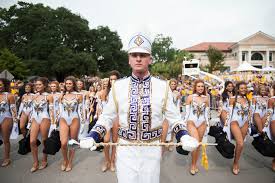File:LSU -Tiger Marching Band (13239809895).jpg.see more details.

The image titled “LSU – Tiger Marching Band (13239809895).jpg” captures a powerful and spirited representation of the Louisiana State University (LSU) Tiger Marching Band, often affectionately referred to as The Golden Band from Tigerland. This legendary ensemble stands as one of the most iconic college marching bands in the United States and is deeply woven into the fabric of LSU’s athletic and cultural identity. The photo likely depicts a vibrant performance, filled with regalia, rich tradition, and electrifying energy that is synonymous with LSU football Saturdays in Baton Rouge.
—
A Rich History of Pride and Performance
Founded in 1893, the LSU Tiger Marching Band began as a modest military band, echoing the discipline and structure of early cadet training programs. Over the decades, it has evolved into a nationally respected powerhouse known for its precision marching, thunderous brass, and innovative musical arrangements. The band has performed at some of the nation’s most prestigious venues and events, from presidential inaugurations to national championship games, and continues to uphold a legacy of excellence.
By the mid-20th century, the band had become an indispensable part of LSU game day traditions. With each performance, the band not only supports the football team but also showcases Louisiana’s musical heritage and the spirit of the South.
—
Game Day Traditions and Tiger Stadium Impact
One of the most anticipated aspects of any LSU football game is the pregame performance by the Tiger Band. When the first notes of the “Pregame Salute” ring through Tiger Stadium, known colloquially as Death Valley, the crowd erupts. The band’s formations, including the beloved “LSU” spell-out, are visually stunning and executed with razor-sharp accuracy.
The Tiger Band leads the “Tiger Walk”, a tradition where the team walks through a path lined with fans, guided and energized by the band. Inside the stadium, the band’s constant presence throughout the game fuels the atmosphere, helping to make Tiger Stadium one of the loudest and most intimidating venues in college football.
Their rendition of the school fight song, “Fight for LSU”, and the hauntingly beautiful “Tiger Rag”, amplify the crowd’s excitement and have become synonymous with the LSU spirit.
—
Iconic Elements and Uniforms
The band’s uniforms are some of the most recognizable in college marching bands. The purple and gold colors, combined with ornate military-style jackets, gold-plumed shakos (hats), and white gloves, make for an eye-catching presentation. In the image referenced, these uniforms likely shine under stadium lights, representing both a modern showmanship and a salute to tradition.
Also notable is the band’s flagship formation: “The Golden Girls” and the Colorguard, who bring flair and choreographed routines to complement the music. The Golden Girls are not just dancers; they are symbols of LSU pageantry and elegance.
—
Membership and Auditions
Composed of over 325 members, the Tiger Band brings together students from across the university’s various colleges and departments. These members balance rigorous academic schedules with the demanding performance and rehearsal commitments of the band. Auditions are held annually, and only the most dedicated and talented musicians, color guard members, and dancers are selected.
Band camp begins before the academic semester, involving long hours of practice in the Louisiana summer heat. This dedication is part of what forges the band’s reputation and strength — a shared sense of discipline, unity, and love for LSU.
—
Awards and Accolades
Over the years, the Tiger Band has received numerous accolades. It was honored with the Sudler Trophy in 2002, often referred to as the “Heisman Trophy” for college bands, awarded by the John Philip Sousa Foundation to recognize excellence in collegiate marching bands. This prestigious recognition underscores LSU’s position at the forefront of collegiate music programs.
Moreover, the band is often featured on national broadcasts, where its performances are praised for their complexity, precision, and crowd engagement.
—
Community and Cultural Impact
The band also performs at parades, local events, and charity fundraisers, reinforcing its role as a cultural ambassador for LSU and Louisiana. The combination of traditional brass band stylings, jazz influences, and classical marching music reflects the diverse musical roots of the state.
During Mardi Gras and other Louisiana celebrations, smaller ensembles drawn from the main band participate in spreading joy and LSU pride across the region.
—
Legacy and Symbol of LSU Spirit
The LSU Tiger Marching Band is more than just a musical ensemble — it is a living emblem of LSU’s heart and soul. The students who don its uniform carry on a tradition that spans over a century, embodying the fierce pride and passion of Louisiana State University. Whether it’s the thunderous boom of the drumline, the flash of the baton twirlers, or the stirring harmony of trumpets and trombones playing “Hey Fightin’ Tigers,” the band moves fans, players, and alumni alike.
This rich legacy, captured vividly in the image titled “LSU – Tiger Marching Band (13239809895).jpg”, serves as a reminder of how music, spirit, and dedication can come together to forge a tradition that transcends generations.
—
In every beat of the drum and every powerful note, the LSU Tiger Marching Band inspires unity, evokes pride, and elevates the game day experience. It’s not just background noise — it’s the heartbeat of Tiger Nation.

